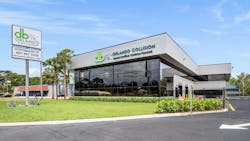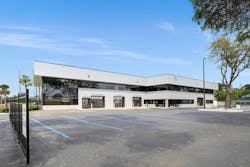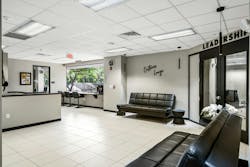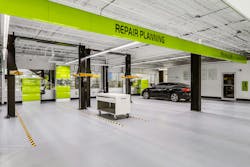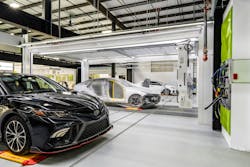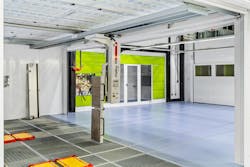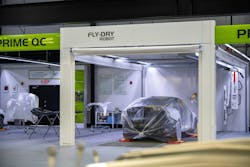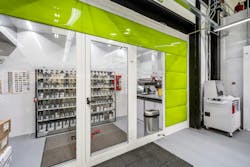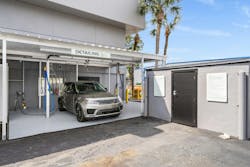DB Orlando Collision
Location: Orlando, Florida
Owner: Drew Bryant
DB Orlando Collision- East (Original location)
DB Orlando Collision-West (New location)
Staff Size
East: 14
West: 18
Annual Revenue
East: $4.5 million
West: projecting $9 million
Average Repair Order
$7,195.60
Average Monthly Car Count
East: 71
West: Target of 133
Shop Size
East: 11,000 square feet Total (1,000 in office)
West: 33,000 Sq Ft Total (10,000 Office/Training) (5,000 ADAS/Mechanical) (18,000 Production Floor)
Drew Bryant, owner of DB Orlando Collision and monthly FenderBender columnist, had some must-haves on his wish list when it came time to expand into his second location. He wanted space for in-house training, and he wanted visibility throughout. Greenfield construction possibilities had proven elusive in part to environmental considerations. A defunct medical technical college checked all the boxes for the blank canvas he was seeking.
A Rocky Start
With multiple OEM certification programs at his first location, Bryant knew what systems, layouts, and processes worked from his first location (still in operation) to perfect the design of a new shop. He drew up a proposal for his bank, leaning on his experience with the Automotive Training Institute and 20-groups, along with the advice of other industry leaders. He recalls the work “exhausting,” requiring the detail of “full-blown, week-to-week projections for five years out.” “But the experience creates a lot of continuity between you and the business,” he says. “You really feel like you're moving the joysticks. And the majority of my presentation was just educating them on, ‘Here's the difference between a traditional standard in this industry versus our performance. And here's how your decision today is going to positively impact the future of the company. It was a lot of just comparing current performance and what the potential would be if we had these additional resources.”
He talked with his banker, with whom Bryant says he has a great relationship. He showed him photos of the building, two stories, all glass paneled, and with no overhead doors conducive to a body shop business. Despite Bryant’s vision, the banker said “no.” Well, not exactly.
“He said, ‘Not a chance in Hell. No way is that happening.’”
Bryant told him he’d abide by the decision but insisted on first having a meeting with the committee who would be making the final decision, though, which was met with skepticism from his banker, Bryant says.
They met at his original location. Bryant laid out his vision through a slideshow. Thirty minutes or so later, they asked him to leave the room.
“Ten minutes later, I came back in, and they told me, ‘We love you, but we were here to prepare how to tell you this wasn't happening. We're all leaving unanimous that we don't care if it's that building or another building, we're all in on you and we're going to make that happen.’”
'Hold my Beer'
It was an exhaustive search to find a suitable location, Bryant says. Greenspaces often included an environmental impact, such as one listing that would require him to provide a sanctuary for gopher turtles that were on one property. Others had included buildings that were in disrepair and probably needed to be razed.
The sweetheart he found sits on four acres with ample parking and another 5,000-square-foot building at the rear of the property, which is the ADAS and mechanical repair facility for the campus. There were hurdles to overcome. And even though it took him about five years for his dream to come alive, he finally made it happen.
“I'm naturally a headstrong person, and every mentor I have, every friend, every peer – every family member who had any remote idea of what I was about to get myself into – told me, ‘Listen, you know, nothing is going to go as planned.
Everything is going to be behind schedule and it's going to cost you twice what you think.’ And naturally, I took that as, yeah, you know? You guys have never worked with Drew Bryant. ‘Hold my beer,’ if you will.”
The challenges mounted, including discovering the blueprints from which he’d been working to redesign the floorplan were based upon when the building was erected in the early ‘80s, and column lines were off a whopping 15 feet.
“We had to completely start over with the equipment on the ground.”
The project originally was slated to be completed January 2024 and is over budget.
“But I'm grateful that we're finally here, and it's exactly how I had in my head. And I learned a tremendous amount about the construction industry. To think we've got that level of mediocrity in the construction industry is absolutely astonishing. But it was an experience, to say the least.”
A Facility Designed for Efficiency
Sitting on four acres with ample parking, the new facility is 33,000 square feet under roof, including 10,000 square feet for training rooms, executive offices, estimator offices, and the main lobby. There is about 22,000 square feet of production space, including two bays for triage and blueprinting. The vehicle’s wheel alignment is first checked so it can be sent out for alignment before calibration is done. Then it transitions to the triage/blueprint area. The original location did not have such an area where the vehicle could be assessed with the customer, Bryant says.
“We couldn’t walk them through what the next steps were without standing in the rain. And being in Florida. It rains almost every day, right? So, we've got two wide open bays with all the amenities for a writer to be able to pull procedures and things with the consumer so it can be done out of the sun, out of the rain. That's going to be big for us over here.”
The new facility includes modular Symach FixLine bays to speed production using its CarMover rail system. Vehicles move sideways on rollers under each tire from one stage to the next. It was a concept Bryant had proven in the previous location, albeit from a different booth manufacturer.
“With [Automotive Training Institute coaching], I was always forced to really study the numbers. And one of the numbers that I'll never forget – that they beat in my head – was the cycle times in the booth. How many could we actually physically get through the booth?”
They found the time needed to mask the vehicle inside the booth was an impediment to pushing through additional booth cycles, especially as the shop’s intensive masking practice has been to mask off the uniside completely, with doors off.
“Once we determined that, we said, ‘OK, well, how do we get this masking done outside of the booth?’ And this was really before I had even heard of side-load systems.”
He moved some bathrooms in the original location’s leased facility and used surface-mount tracks for the on-deck and paint workstations.
As he and his fixed operations manager, Rick Nanlall, predicted, having a masked vehicle “on-deck” ready to go nearly doubled the number of booth cycles. So when it came to designing the new building, Bryant was sold on the concept and wanted to expand it to include multiple processes.
“I went to three different booth manufacturers. One came back with a pencil and lined paper with an idea. Another one said, ‘Look, you know we've got some pieces, we can try to make it work.’ And Symach just said, look, we hear you. This is our specialty. And what they presented almost on first kickback was about 80% of what I envisioned. So it just seemed natural, right? At that point, I really wasn't price-shopping. I was in on the fact that they were receptive to what I wanted, and I felt as though I had the highest confidence of them executing it.”
The new facility includes six Symach bays: 1) Final prep; 2) Pre-prime/QC; then the vehicle moves to the next station, where 3) the Fly Dry’s robotic infrared arm dries the primer. 4) At the Pre-Paint station, technicians use vacuum sanders to sand. It’s then 5) rinsed and masked for paint, followed by the 6) DryKing paint booth.
“The only part of that process we don’t have is the dry cabin,” Bryant says. “When I looked at it for the vehicles that we’re doing and the typical jobs that we were running through our system, the gain of efficiency and the accommodation of the space that we had, it made sense to do without it. After we bake, it drives right out the front of the booth and heads over to the other side of the building for reassembly and final QC.”
Other Upgrades
The new facility features three frame benches from Spanesi. Although the number of heavy hits resulting in a total is ever-increasing, Bryant says it’s standard operating practice to use them to measure any significant damage.
“We're always going to mount it at least to the pinch weld…maybe not full jig, but we want to have a good solid baseline. The margin of error, you know you're talking about millimeters based upon the hair on somebody's arm, right? And I'd much rather have a vehicle at a baseline position.”
They’re also useful to reduce technician fatigue, as vehicles can be raised so the rocker panel is at the technician’s eye level. The shop is also doing aluminum repair at the new location.
The new location has converted to Spies Hecker Permahyd Hi-TEC waterborne basecoat.
“It offers a substantially better color match,” Bryant says. “We’re noticing lots of efficiencies with just the color itself when we were testing it. It’s not that solvent didn't get the color eventually; it was just a lot of time that was going in, especially with these newer colors on newer models. And then separate from the color match, we're big on technician health. And they wear fresh air systems and they're blowing conditioned air across their face when they're painting. And I plan to update the other facility to follow in line.”
The parts department also includes a separate room with 3M’s RepairStack to manage materials by requiring a key card for access and provide accountability has returned materials to being a profit center.
Every bay in the shop has a 65-inch TV on the wall with a synclient touchpad and mouse. This allows shop management to assist technicians with researching an OEM repair procedure.
“And if a technician is having a challenge, we can log in, get to the information we believe they need, and immediately cast to that so they can follow along. We're working hard to make sure that we're not being the Easy Button, if you will, or handing them all the answers. We're really wanting to show them how to get there and you know, leverage the resources that they have. So that way you know they can develop as individuals and having the ability to do that in every single stall is exciting.”
About the Author
Jay Sicht
Editor-in-Chief, FenderBender and ABRN
Jay Sicht is editor-in-chief of FenderBender and ABRN. He has worked in the automotive aftermarket for more than 29 years, including in a number of sales and technical support roles in paint/parts distribution and service/repair. He has a bachelor's degree in journalism from the University of Central Missouri with a minor in aviation, and as a writer and editor, he has covered all segments of the automotive aftermarket for more than 20 of those years, including formerly serving as editor-in-chief of Motor Age and Aftermarket Business World. Connect with him on LinkedIn.
Don't miss Jay's next article or podcast. Sign up for FenderBender Today's Collision Repair News and ABRN eNews here.
